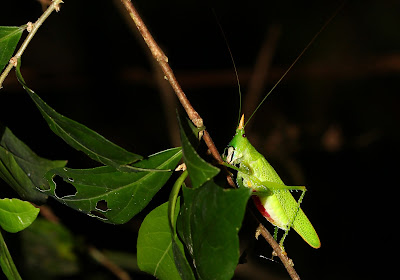 |
| Grasshoppers - order Orthoptera |
Surprisingly one of the most common and varied orders is the grasshoppers/katydids. From the tree tops to underground you can find members of this group and they come in a number of shapes and colours. There are those that imitate leaves down to the last detail,
 |
| Leaf Katydids - tribe Pterochrozini |
 |
| Bolivars Katydid - Typophyllum bolivari |

those that imitate walking sticks.
 |
| Jumping Stick - family Proscopiidae |
Those that are brightly coloured,
 |
| Short-Horned Grasshoppers - families Arcididae & Romaleidae |


and a number that are just strange.
 |
| Conehead katydid - subfamily Copiphorinae |
 |
| Mole Cricket - family Gryllotalpidae |
 |
| Airplane grasshopper - Pseudomastax personata |
Besides those already mentioned you can find the largest katydid in the world (Spiny Lobster - Panoploscelis specularis), grasshoppers that imitate wasps and even those that are carnivorous. Regardless of your personal feelings toward invertebrates in general, its hard not to have your curiosity piqued by at least one insect. If grasshoppers aren't your cup of tea there are many other groups that may intrigue you. For those of you with a phobia of insects don't let your fear stop you from visiting the beautiful amazon, like most animals if you leave them alone they will return the favour.
If you would like to experience the amazing biodiversity found in the Amazon rainforest check out our website
or email us